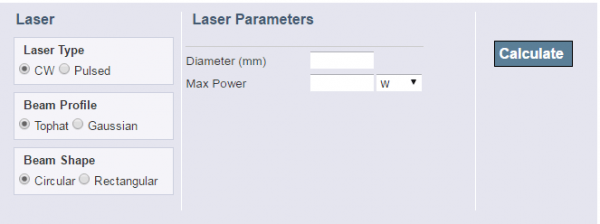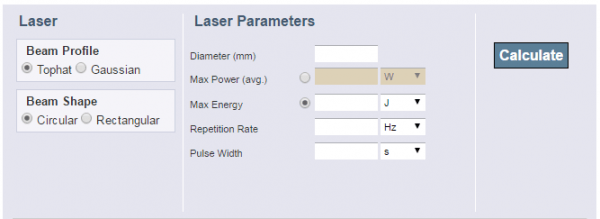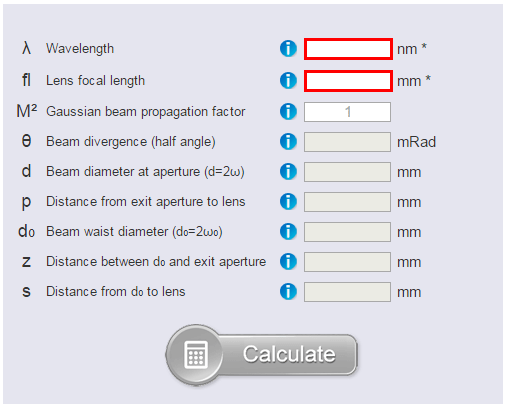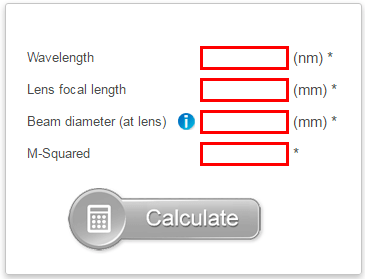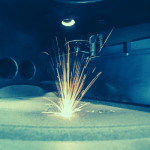Laser Beam Optics Calculators
A laser is a complicated animal.
Whether you’re a lab researcher or an industrial worker, there are several parameters you might need to calculate, such as power density or ideal focus spot size.
We’ve recently added a few calculators to our website. I hope these calculators make your work just a little bit easier.
We have five laser optics calculators (so far):
Power Density
Our first calculator is for laser power density. Enter the beam size and power to calculate the power density of your beam.
Power density is the simplest yet most complete way to describe your laser with only one value. This will determine the success or failure of your application more than anything else. But most measurement devices will give you either the beam size or the power, but no the power density. Use this calculator so you don’t need to get out your pen and paper (and to avoid mistakes!).
Peak Power
Let me be frank. Pulsed laser beams are a hassle to calculate.
Where CW is pretty simple (see above – just size and power), pulsed beams have many more parameters: beam size, pulse energy, peak power, average power, repetition rate, and pulse width.
One point of particular consternation is peak and average power. The calculation itself is not complicated, but it can get confusing – do I need to multiply or divide? Do I need to use pulse width or repetition rate?
That’s what the laser peak power calculator was made for.
Focal Spot Size Calculator
This calculator was cooked up by our physicist. Based on Self’s equations, it calculates the focus spot size and position of the laser beam waist after placing a certain lens in front of the laser:
Enter the wavelength, lens focal length, and M2, and then enter three of the remaining six fields. The calculator will calculate the other three as soon as the information is available:
Then click calculate to get the new beam waist position and focal size, as well as the new Rayleigh length.
Laser Focusability
This calculator is very similar to the above, but it’s a much simpler version. In this case, you only need to input four parameters (total) and you get the ideal diffraction-limited focused beam size:
Power through Aperture Calculator
Gaussian laser beams have more energy outside its 1/e2 beam diameter than you might think. Since the intensity distribution is like a bell curve, there is a non-negligible percent of your laser outside the beam width (13.5%, actually). So use this calculator to see how big your aperture must be to transmit (say) 99% of your beam.
Important – What else do you need to calculate?
Of course any comments on the above calculators are welcome.
But if you have some things that frustrate you, annoying calculation you need to make every day – let me know in the comments below! We’re here to help. So, no, I can’t promise anything, but if it makes sense I’d love to expand our calculators to anything else laser-related you may need.
Hope this helps in all your laser endeavors!
Sensor Calculations
Read more about this
Laser Calculators

Laser Focusability Calculator
For a collimated beam, the diffraction-limited focal spot size of a laser beam depends on its wavelength

Temperature Rise Calculator
Calculator for Temperature Rise in Uncooled Laser Power Sensors

Laser Focal Spot Size Calculator
Use this calculator to get the size and location of your Gaussian laser beam waist at focus, as well as the Rayleigh range.

Laser Power Through Aperture Calculator (Gaussian Beam)
Gaussian laser beams have power intensities in the shape of a bell curve (Gaussian).

Laser Peak Power Calculator
Use this calculator to determine the peak power of your laser beam.

Power Density Calculator
What is this calculator for? Use this calculator to determine the power density and/or fluence (energy density) of your laser beam.
